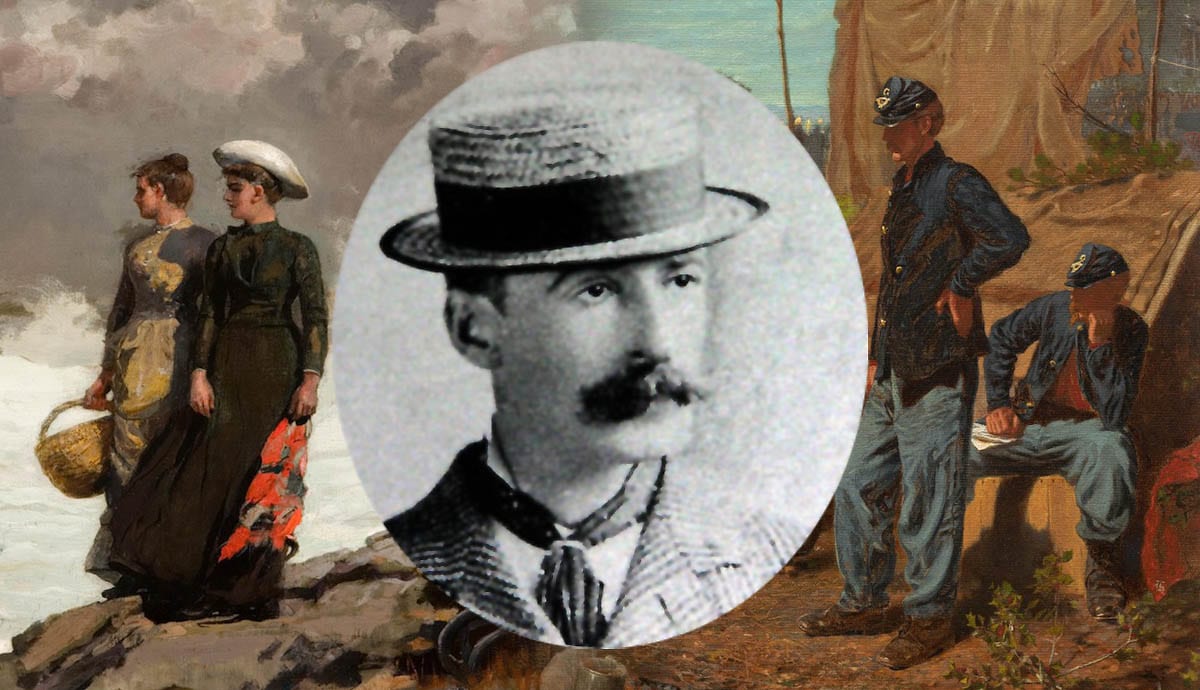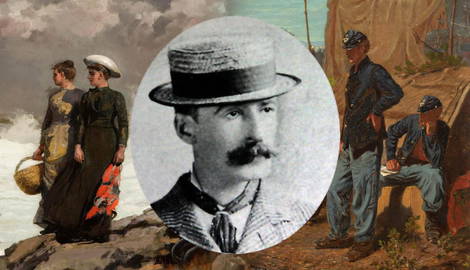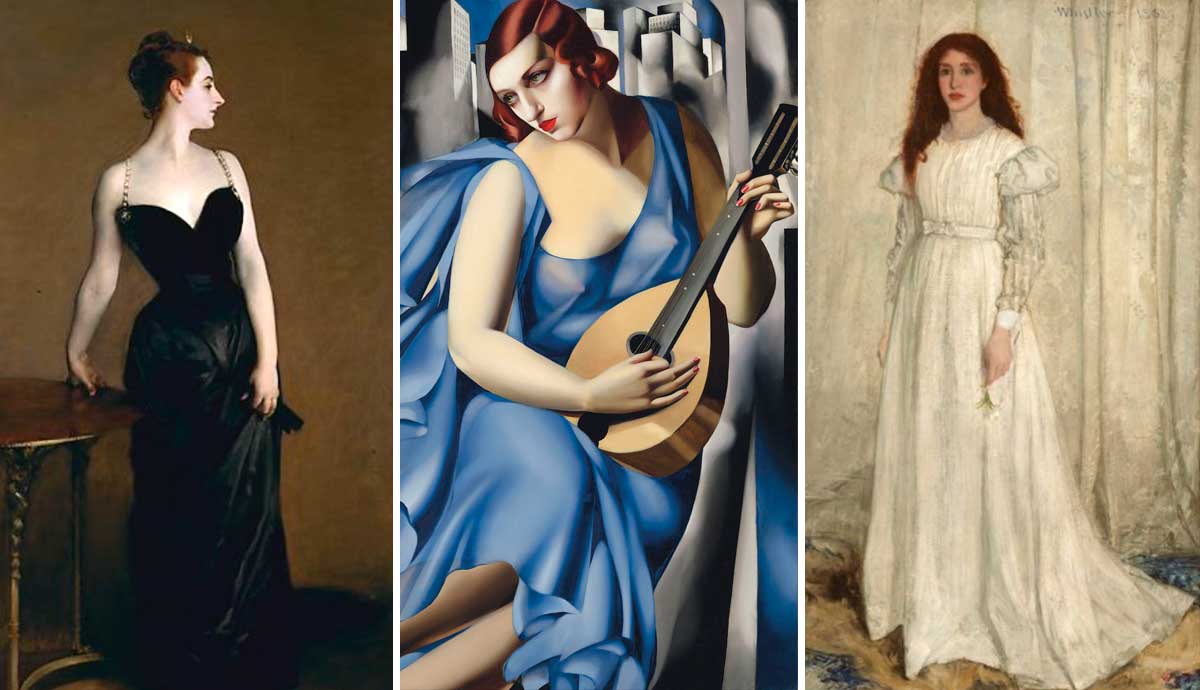
Winslow Homer is an American painter known for creating images of the Civil War and serene summertime paintings of women and children relaxing by the seaside. However, Homer created a wide range of works that still provoke discussions today. Homer’s illustrative skills and corresponsive experience would help to prepare him for his work as a storyteller depicting different perspectives of people’s lives during 19th century America.
Images of the Civil War: Winslow Homer’s Harper’s Weekly Illustrations

During the American Civil War, imagery and reports from the frontlines of battle became a pioneering source of news reporting. Winslow Homer started working as a freelance illustrator for magazines during the mid-19th century. He worked for Harper’s Weekly during the Civil War as an artist-reporter. He created illustrations of less represented war scenes, such as women acting as nurses or writing letters for soldiers, as well as African-American teamsters at work or rest. It is these different perceptions of the war that would greatly influence the American painter in his later works during life after the war.
Instead of focusing on dramatic images of the battlefield, Winslow Homer’s work also depicted images of soldiers’ everyday lives. His illustrations included such images as soldiers celebrating Thanksgiving or playing football, or living in barracks and eating meals. Like the men that he depicted, Homer had to suffer harsh climates, lack of food, uncomfortable living conditions, and he saw the violent events and aftermaths of battle. This sense of camaraderie with his fellow correspondents and soldiers allowed him to have a different perspective of life during the war. This translated into giving viewers a first-hand experience and made it more relatable for viewers at home.
American Painter Of The Civil War

Winslow Homer’s travels with the army gave him recognition and became a catalyst for his career as an American painter. The painting above titled Sharpshooter was originally an illustration for the magazine, yet became the image for his first oil painting. The viewer is placed underneath the soldier on a lower branch, looking up at a sharpshooter, who is poised to shoot. The image is surrounded by the leaves and branches of the tree as if the viewer is immersed in the foliage with the sharpshooter. His face is partially concealed with his hat and armed position, which gives a cold, detached emotion.
The rifle enabled soldiers to kill from afar, not in close range, which Winslow Homer witnessed and used to add a horrific element to his work. It is unclear whether or not the sharpshooter will be taking a life or saving one. Unlike other battle scenes, Homer depicts a solitary soldier in a calmer setting.

The painting above is Prisoners from the Front and shows the Union officer (Brigadier General Francis Channing Barlow) capturing Confederate officers on a battlefield. This is one of Winslow Homer’s most well-known images of the war and depicts the city of Petersburg, Virginia being taken by the Union. Petersburg was crucial in winning the war because of its supply lines and was one of the last major cities to be captured.
Here it appears almost a desolate wasteland with tree stumps and twigs strewed on the ground. The middle Confederate soldier is old and haggard standing next to an upright and proud soldier who is still defiant. It speaks to both the tragedies caused by the war while showing a defining moment that signified the end of the war. Winslow Homer completed this painting after the war was over, and this could have had an impact on how he chose to illustrate this scene as x-rays show he changed the image multiple times.
Return To The South: The Aftermaths Of The War

Like Prisoners from the Front, many of Winslow Homer’s Civil War illustrations served as inspiration for works created after the war was over. Near Andersonville is one of Homer’s paintings that reflects the standstill of formerly enslaved peoples. Here a woman is standing in between a darkened doorway into the bright sunlight of day. It is a metaphor for a dark past and stepping forward into a hopeful and brighter future. The setting is at the Confederate prison camp in Andersonville, Georgia. In the background, Confederate soldiers take captured Union soldiers to the prison. It is a contrast between the optimistic sides after the war’s end against the reality that there were still dark things afoot in the South.
Next to the door are drinking gourds growing with green sprouting vines. It references the Big Dipper constellation, which is also known as a drinking gourd and is a symbol of freedom. The only other sources of color besides the green vines are the woman’s red headscarf and the red of the confederate fag off to the left of the image. Like his other paintings, red is used in times of danger, as red can signify a warning of an impending threat.

Winslow Homer returned to the South during the 1870s to Virginia. What emerged from a post-Civil War America inspired some of Homer’s most insightful pieces of art. A Visit from the Old Mistress is a painting of four formerly enslaved peoples staring at their former Mistress.
The African-American woman stands at eye-level and looks directly at her old Mistress. It defines the tensions between the former Masters/Mistresses to the newfound freedom of formerly enslaved peoples. The scene symbolizes the limbo between the abolishment of slavery and the struggles of defining a new way of life for the people in the painting. Winslow Homer strongly contrasts the strict Southern woman who is a symbol of the past against the group of women who are looking towards the future. Homer rarely created portraits and instead portrayed people in the middle of an action making the viewer feel as if they have stumbled upon the scene and are viewing it from another perspective.

This painting titled Sunday Morning in Virginia depicts a teacher with three students and an elderly woman in a slave cabin. Here Winslow Homer contrasts the new generation against the old. A teacher is sitting with three children huddling around her as she teaches from a Bible. The clothing of the woman indicates that she is a teacher, not a member of the household because it contrasts with the worn-out clothing worn by her pupils. Homer’s contrast of clothing shows the advancements possible for future generations while also showcasing the current circumstances and struggles facing the nation. Homer later focused on subjects of teachers, schoolchildren, and the schoolhouse. He demonstrates how the power of education played an important role for future generations.
Another contrast is the elderly woman sitting next to the group of children. Even though she is physically close by there is still a sense of detachment and distance represented. She faces away from the children learning. Her age indicates the education she was denied and is further emphasizing the not-so-long-ago painful past. She is also wearing a vibrant red shawl and similar to other paintings Winslow Homer uses red during precarious situations. However, he also subdues this with imagery of rebirth and hope. Homer’s intentional positioning of the younger formerly enslaved peoples indicates possibilities for a more equitable society, yet acknowledges potential danger.
The Maritime Adventures Of Homer’s Ocean Paintings

Above all, Winslow Homer is a storyteller and this is demonstrated particularly in his maritime paintings. He used his experience as a reporter and storyteller to depict epic scenes of survival and demise. Throughout his travels to Europe and back to America, Homer became inspired by the tales/myths of the ocean. He traveled to England during the early 1880s and witnessed the lives and activities of people in the fishing village of Cullercoats until eventually settling in Prout’s Neck, Maine, which greatly influenced his subject matter.
An example of this is The Fog Warning pictured above which depicts the encroaching fog coming over to threaten a fisherman. Winslow Homer uses dark undertones to heighten the suspense of the scene. Instead of vibrant blues and calm skies, the ocean waves are deep indigo while his sky is a steel gray. It is unclear whether or not the fisherman has time to return to safety, as the ship is far off in the distance. There is an inherent sense of dread for the fisherman as his fate is left unknown. Homer emphasizes this drama with the fog clouds spiking out against the waves spraying up into violent misty foam that collides against the horizon. It is the sharpness of the waves that appears deadly and ominous. The diagonal angle of the boat also lends to this as well because diagonal lines are naturally uneven causing dizziness and disorientation.

Winslow Homer’s painting The Life Line depicts a perilous situation of a rescue during a storm. He shows the two figures on a breeches buoy, where a pulley would transfer people from a wreck to safety. This was a new form of marine technology and Homer uses it in a seemingly confusing and chaotic situation. The man’s face is obscured with a red scarf and the woman’s dress is folded between their legs, making it hard to distinguish between the two. The red scarf is the only contrasting color within the scene, and it immediately draws the viewer’s eye towards the woman who is in strife.
Winslow Homer was inspired by Japanese woodblock prints and used them to study color, perspective, and form. He used these as inspiration not only for his maritime paintings but his other nature paintings as well. Similar to Japanese prints, he used asymmetrical lines for the waves, which practically cover the entire image. The sea encompasses the subjects and draws viewers inside the midst of the tempestuous storm, heightening the sense of urgency of the scene.
Harvesting A New Future: America’s Agrarian Past

From Winslow Homer’s sea paintings to his scenes of the Civil War and Reconstruction, he has dealt with themes of life, death, and morality. The changing of seasons, times, and politics of the nation are consistent themes of Homer’s. In the painting above, a farmer harvests a field of wheat set against a clear blue sky. Everything seems idealistic with a simple farmer and wheat field signifying the path towards change in America after the Civil War.
However, there are other contradictory symbols in this image. The farmer carries a sickle and faces away from the viewer. This object brings to mind a Grim Reaper sowing the freshly harvested plants, and the fact that the viewer does not see his face only heightens this mystery. It can also signify the hardships facing a divided nation. It also shows Homer’s interest in agrarian imagery and creating pictures that resembled a past way of life. These types of nostalgic images became popular during this era and became some of Homer’s most commercially successful paintings.

Many of Winslow Homer’s paintings after the Civil War focused on images of school children and women either in school settings or surrounded by nature. He focused on this idealistic view of youth and rejuvenation, which became popular subjects to inspire a public ready to move forward. Here he chooses to illustrate schoolboys playing a game during recess. It is one of Homer’s most beloved paintings as it displays the sweet innocence of childhood. The one-room red schoolhouse in the background is a longing for the way rural America used to look like because these types of schools were less popular due to the growing amount of people moving to urban cities.
Compared to Winslow Homer’s war or sea paintings the colors he used here are vibrant and lively. The sage green fields are full of springtime wildflowers and there is an endless blue sky filled with soft white clouds. These colors become more frequent in his works compared to his previous works. His Civil War paintings are muted in tone because of the destruction of wildlife to create the trenches and battlefields during the war. He experimented with color and subject matter in the wildlife paintings that he completed towards the end of his life.
Winslow Homer’s Examination Of The Hunt

Another medium Winslow Homer excelled at was watercolor, which he used for images of the ocean and land. Later in his career as an American painter, he transitioned to recording subjects of hunting particularly in the New York Adirondack Mountains. Like his ocean paintings, Homer depicts man versus nature and he showcases this by depicting men hunting deer in the forests of New York. On the Trail shows a man with his hunting dogs searching for their prey. Even during this hunt, Homer still surrounds the hunter with a prevailing forest of leaves and brush. These elements completely consume the image and demonstrate that no matter what; nature is always prevailing and is a larger force than men.

Here is an example of one of Winslow Homer’s animal paintings of two ducks in the midst of death. This became a subject that the American artist used in his naturalistic paintings towards the end of his life. There is no evidence of a hunter or his weapon, but the birds’ dramatic flailing positions lead to this conclusion. On the left duck there is a small amount of red paint, but whether or not the ducks were hit or are flying away is still uncertain. Their erratic movement is exemplified by the spikey waves of the water below them. This image also showcases Homer’s study of Japanese woodblock prints. The influence of Japanese art grew in Europe during the 1800s and it can help explain Homer’s continual choice in subject matter relating to the natural world.

Winslow Homer’s The Fox Hunt is one of his last paintings. Here he shows the fox searching for food while being stalked by crows hunting during winter. Similar to The Sharpshooter Homer uses perspective to further heighten tension and suspense. The viewer is placed at eye level with the fox so that the crows appear larger while they loom over the fox. The fox is slanted at a diagonal, which emphasizes the fox’s struggle moving through the thick snow.
The fox’s red hide also contrasts strongly against the whites and blacks/greys of the image. The other specks of red are the berries located on the left that signify the coming of spring and new life. Winslow Homer’s use of morality is significant in these nature paintings just as his other works. He created scenes that are times uncomfortable to look at, yet he manages to draw the viewer in with his masterful use of drawing and storytelling.










